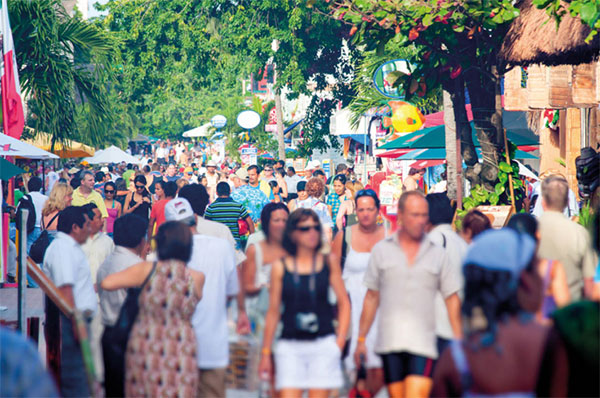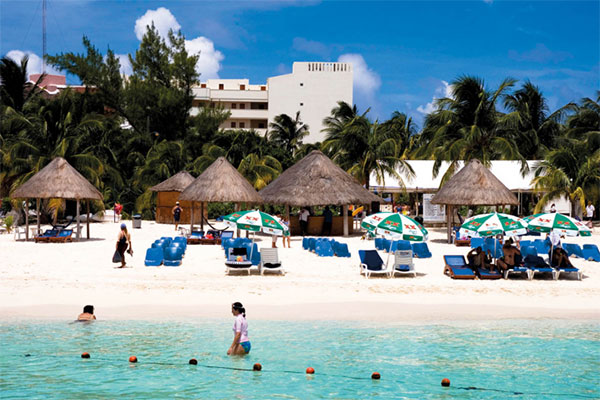TOURIST TRAP
The turnover of the region to tourism may have brought much-needed wealth – but at what cost?
Bathed with water so turquoise it seems to define the Caribbean dream, blessed with mile after mile of ravishing sandy beaches and boasting a climate that’s utterly tropical, it is easy to understand the meteoric rise of Cancún from desert island to über-resort. Present-day visitors will probably have trouble imagining how pristine the area was back in the 1960s.
The statistics relating to Cancún and the Riviera Maya – a tag only dreamed up in 1998, but which has become an inescapable part of the scenery – defy the imagination. The growth of Cancún in 30 years from a few first hotels to a city of 700,000 is widely recognized; it is less well known that neighboring Playa del Carmen, which in 1995 could still be talked about as a sleepy off-Cancún retreat, has grown in population by more than 500 percent in little over 10 years.
Limits to growth
Much is made of the idea that Cancún’s creation came about through a rational, planned process, after Mexican officials concluded that the northern Quintana Roo coast was one of the most beautiful places on earth, and ideally located for easy access from North America and Europe. The explosive expansion of the Riviera has created new urban realities, in downtown Cancún – conceived as just a ‘dormitory’ for hotel workers, but now very much a real city – or the sprawl of Playa del Carmen. Tourism is now inseparable from the Yucatán, its economic motor. Few have not benefited in some way from it, from middle-class car-rental agents to Maya farmers who spend a few months each year working on construction sites – although the wealth from tourism is distributed extremely unequally.

Crowds on Playa del Carmen.
Getty Images
The big potential problems of the Riviera – beyond the open sore of inequality – stem from its sheer, unceasing momentum. Many developers seem to work on the assumption that there are no limits to tourist growth. Many sneer at Cancún on taste grounds, but as a source of environmental damage it is less significant than the self-contained, all-inclusive resorts spreading down the coast that are blocking the flow of nutrients between the mangroves and the reefs, which is essential for their survival. And the Riviera’s people – tourists and residents – produce vast amounts of garbage. There are now more than a dozen golf courses around the Riviera, although this is one of the worst places in the world to build one as they’re fed a cocktail of chemicals that later sinks through the thin limestone subsoil and into the sea.
Many are trying to develop alternatives. For tourists, there are of course other ways of enjoying the region than going straight from the airport to an enclosed resort, such as diving or taking wildlife tours with small-scale operators. Many such operations are based around preserves and work closely with Maya communities, aiming to ensure a more equitable distribution of the tourist dollar.
Basic needs for sustainability
Non-utopian environmentalists suggest there are three essential measures needed on the Riviera Maya: a solution to the garbage problem; a complete ban on new building within half a kilometer of the coast; and strict enforcement of proper, filtered drainage standards. Many developers only think in terms of their first five-year results, but the future of this coast is dependent on maintaining its beauty.
Isla Mujeres
A very different atmosphere can still be found on Isla Mujeres 6 [map] , about 8km (5 miles) long, with only two main roads and nowhere more than 1km (0.6 miles) wide. Some have suggested the name ‘Island of Women’ derives from 17th-century pirates who kept their women sequestered here, but it was actually given by some of the first Spaniards who arrived on the island because of the many female idols they saw honoring Ixchel, the Maya goddess of fertility. At the island’s southern tip are the tiny ruins of the Temple of Ixchel.
Passenger ferries to Isla Mujeres run from Puerto Juárez just north of Cancún, operated by the Magana and Ultramar companies; both have boats every half-hour, usually 5am–9.30pm (from Isla, 5am–midnight) and then hourly after that. The trip takes 20 minutes. Ultramar also run a handful of ferries direct from the Cancún hotel zone.
Many of today’s Isla visitors spend their time on the compact town beach, Playa Norte, where the water is very shallow, or snorkeling a couple of miles south in El Garrafón Reef Park (winter daily 10am–5pm, summer until 6pm), a natural rock pool. Taxis run all around the island, but the most popular way to get around Isla is by renting a golf cart. Isla Mujeres is the best scuba-diving and snorkeling center close to Cancún. At Los Manchones, a reef off the southern tip, crystal-clear waters flow around a 3-meter (10ft) bronze crucifix, placed there in 1994 to mark the 140th anniversary of the island becoming a township. The Cave of the Sleeping Sharks, in deep waters off the southeast coast, is so called because sharks lie there immobile for hours at a time, a rare phenomenon explained by the fact that an underground river emerges into the sea there.

Playa Norte on Isla Mujeres.
Alex Havret/Apa Publications
Isla Holbox
Just around Cabo Catoche, the meeting point of the Caribbean and the Gulf of Mexico, is Isla Holbox 7 [map] . A narrow strip of mangrove and beach, Holbox has just one village, with sand streets and very few motor vehicles – golf carts and bicycles are the main traffic. Along the beach there are several laid-back, palm-roofed hotels, from simple to luxurious. Idyllically relaxing, Holbox is also a wonderful place for fly-fishing, bird-watching, or snorkeling, especially around Isla de Pájaros in Laguna de Yalaháo, between Holbox and the mainland. Holbox also has a special attraction: the gathering off Cabo Catoche, every year from May to September, of large numbers of whale sharks, the world’s largest fish, which mass to feed on a rich soup of tunny fish spawn and plankton that the sea serves up at that time of year.
To get to Holbox you must first get to the little port of Chiquilá, 160km (110 miles) or a 2.5-hour drive from Cancún, from where passenger ferries leave about every two hours.